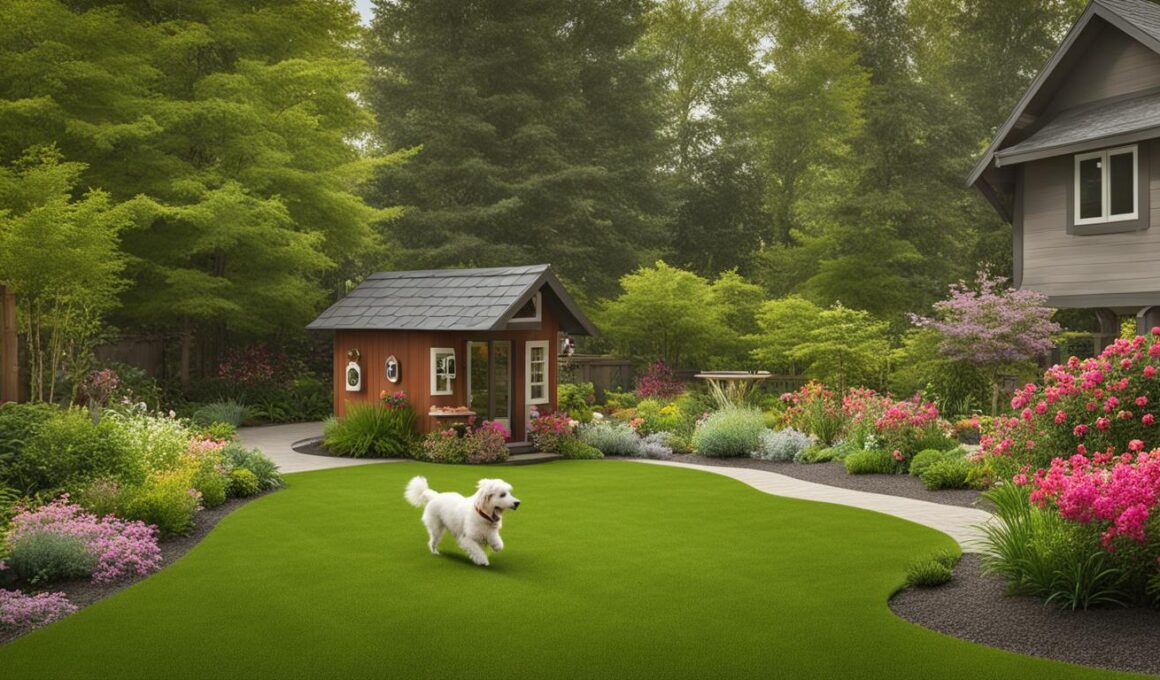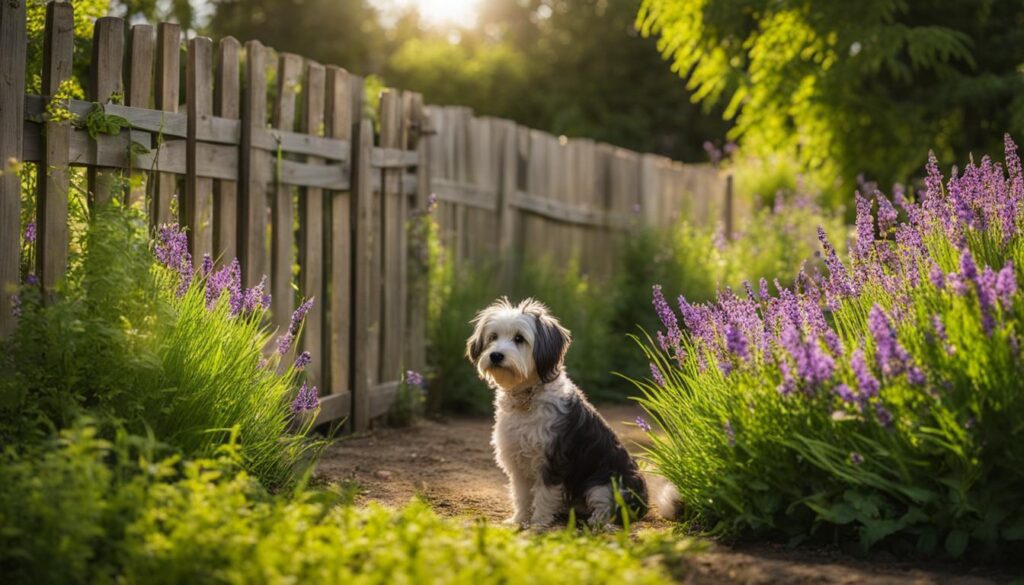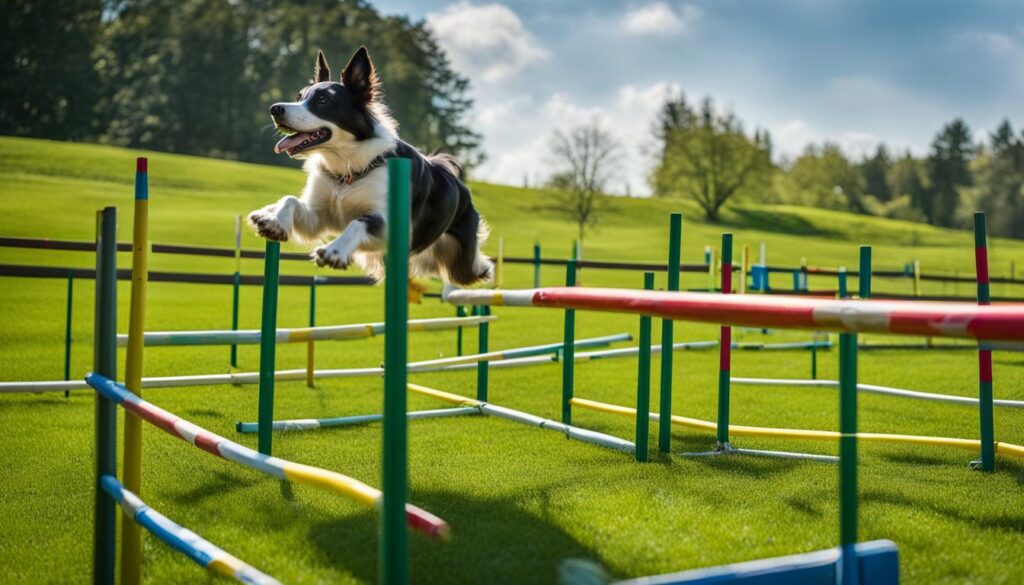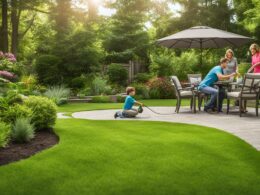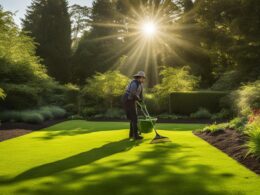Creating a yard that is both dog-friendly and aesthetically pleasing is important for dog owners. Dogs love spending time outdoors, but their playful nature can sometimes lead to damage to your lawn and garden. By implementing dog-friendly landscaping ideas, you can ensure that your yard remains beautiful while providing a safe and enjoyable space for your furry friend.
Key Takeaways
- Choose landscaping elements that are both durable and safe for dogs.
- Create a cool down space for your dog with a splash pool or water feature.
- Plant flea-repelling plants and use cedar chips to keep your yard free from pests.
- Designate a sandbox for your dog to satisfy their digging instinct.
- Create a pathway using paving stones or pea gravel to redirect your dog’s movement.
Now let’s explore some dog-friendly landscaping ideas to transform your yard into a paradise for your pooch.
Creating a Cool Down Space for Your Dog
Dogs need a space to cool down during hot summers.
A splash pool or a water feature, such as a fountain or shallow pond, can provide a refreshing spot for dogs to play and relax.
Hard plastic kiddie pools or a carefully constructed water feature made of smooth stones are good options for durability and safety.
Using Flea-Repelling Plants in Your Yard
Fleas can be a nuisance for you and your furry companion. Thankfully, you can naturally repel these pesky insects by incorporating flea-repelling plants into your yard. Not only will these plants help keep fleas at bay, but they are also non-toxic, ensuring the safety of your beloved pet.
One effective flea-repelling plant is catnip. This herb possesses natural chemicals that repel fleas, making it a great addition to your yard. Additionally, marigolds not only brighten up your garden with their vibrant colors but also release an aroma that repels fleas.
Did You Know? Planting rosemary and sage in your yard can also help deter fleas. These herbs contain strong scents that fleas find unappealing.
To further boost your flea-repelling efforts, consider using cedar chips as mulch in your garden. Fleas dislike the scent of cedar, making it an effective natural deterrent. Spread a layer of cedar chips around your plants to create an environment that is unfriendly to fleas.
However, it’s crucial to exercise caution when selecting flea-repelling plants for your yard. Some plants that are effective in repelling fleas may be toxic to dogs. To ensure your pet’s safety, always refer to the list of toxic and non-toxic plants provided by the ASPCA before adding any plants to your yard.
Flea-Repelling Plants:
- Catnip
- Marigolds
- Rosemary
- Sage
Tips for Creating a Flea-Repelling Garden:
- Plant a variety of flea-repelling plants throughout your yard.
- Use cedar chips as mulch to provide additional protection.
- Regularly check and maintain the health of your plants to optimize their flea-repelling properties.
Designating a Sandbox for Digging
Dogs have a natural instinct to dig, which can lead to damage in your lawn and garden. But don’t worry, there’s a solution! By designating a sandbox for your dog to dig in, you can provide them with a designated area to satisfy their digging urge without causing harm to your precious plants and pristine lawn.
Building a doggy sandbox is a simple process that involves a few key steps. First, dig a pit in a suitable location in your yard. Make sure it’s large enough for your dog to comfortably dig in. Then, line the pit with concrete to prevent your dog from digging out of the designated area.
Next, fill the pit with playground sand. This soft and safe material will provide your dog with the perfect texture to satisfy their digging instinct. It’s important to choose playground sand over regular sand, as regular sand can be too fine and dusty for your dog’s comfort.
Once your sandbox is complete, introduce it to your dog and encourage them to use it. You can sprinkle some treats or toys in the sandbox to pique their interest. With a little bit of training and positive reinforcement, your dog will quickly learn that the sandbox is their designated digging area.
The sandbox will not only protect your lawn and garden but also provide a fun and engaging activity for your dog. It’s a win-win situation! So go ahead and create a sandbox for your furry friend, and watch them enjoy their very own digging paradise.
Creating a Pathway for Dogs
Dogs are known to create pathways in yards by repeatedly walking over the same area. This behavior often leads to thin or bare patches of grass, which can be unsightly and challenging to maintain. However, you can redirect your dog’s movement and prevent further damage to your lawn by creating a dedicated dog pathway using paving stones or pea gravel.
Paving stones are an excellent option for creating a durable and visually appealing pathway for your dog. Their sturdy construction can withstand constant foot traffic and provide a solid surface for your dog to walk on. Additionally, the interlocking design of these stones ensures stability and prevents them from shifting or sinking into the ground.
Adding a dog pathway not only protects your lawn but also creates a defined space for your dog to follow, keeping them away from delicate plants and flowers.
If you prefer a more natural look, pea gravel is an alternative to consider. This small, smooth gravel is comfortable for your dog to walk on and doesn’t retain heat like other materials, making it suitable for hot summer days. Additionally, pea gravel allows for proper drainage, preventing water from accumulating on the pathway and causing mud or puddles.
A well-designed dog pathway should blend seamlessly into your yard’s landscaping and complement the overall design. It is essential to plan the pathway’s layout strategically, taking into account your dog’s walking patterns and any existing features in your yard. You can create curving or straight pathways, depending on your preferences and the available space.
An important consideration when installing a dog pathway is the depth of the paving stones or gravel. The pathway should be flush with the surrounding ground, ensuring a smooth transition for your dog to walk on. To achieve this, you may need to excavate the area slightly and provide a suitable base for the stones or gravel to sit on.
Remember, your dog’s safety is paramount. Be sure to inspect the pathway regularly for any loose or damaged stones that could pose a tripping hazard. Also, monitor your dog’s behavior on the pathway initially to ensure they adjust comfortably to the new walking surface.
Adding a Dog Window to Your Fence
In addition to creating a dog pathway, another way to enhance your dog’s outdoor experience is by adding a dog window to your fence. A dog window, also known as a peek-a-boo window or doggie window, is a small opening in your fence that allows your dog to see beyond the confines of your yard.
The dog window provides entertainment and mental stimulation for your dog, as they can observe the world outside while staying within the safety of your yard. It also serves as a distraction, preventing your dog from digging or attempting to escape by satisfying their curiosity.
To install a dog window, choose a location on your fence that offers a clear view and is easily accessible for your dog. The window should be situated at a height where your dog can comfortably look through it without straining.
When selecting a dog window, opt for a durable and weather-resistant material, such as acrylic or polycarbonate. These materials are transparent, lightweight, and able to withstand outdoor conditions. It is also advisable to choose a window with rounded edges to minimize the risk of injury.
Important: Before installing a dog window, check with your local authorities or homeowner’s association to ensure compliance with any regulations or guidelines regarding fence modifications.
A dog pathway and a dog window are practical additions to your yard that can enhance both your dog’s experience and the overall aesthetics of your outdoor space. By redirecting your dog’s movement and providing a window to the outside world, you can create a dog-friendly environment while preserving the integrity of your lawn and garden.
Designating a Dog’s Own Personal Space
Fencing in a section of the backyard and turning it into a designated dog area can provide an ideal space for your dog to run and play freely. This area should include plenty of room to move around, a water source for hydration, a shelter from the elements, and plenty of toys to keep your dog entertained. Having a designated dog area can give you peace of mind knowing that your lawn and garden are protected while still allowing your dog to enjoy outdoor time.
Creating a dedicated space for your furry friend ensures that they have their own personal sanctuary within your yard. To establish a designated dog area, start by installing a sturdy fence that encloses the space. This will both keep your dog contained and provide a visible boundary for them. Consider using a durable material like wood or metal to ensure the safety and security of your pet.
Inside the designated dog area, provide ample space for your dog to run, jump, and explore. Dogs love to play, so incorporate various elements like ramps, tunnels, and obstacles that promote physical activity and mental stimulation. This will keep your dog entertained and prevent them from feeling bored or restless.
A water source is essential to keep your dog hydrated during outdoor playtime. Consider installing a self-refilling water bowl or a small dog-friendly fountain within the designated area. This ensures that your dog always has access to fresh water, especially during hot summer days.
Additionally, provide a sheltered spot within the designated area where your dog can seek refuge from the elements. This can be a doghouse or a covered area that protects your pet from sun, rain, or snow. Make sure the shelter is comfortable, well-ventilated, and provides adequate protection against extreme weather conditions.
To keep your furry friend entertained within their designated space, include a variety of toys that cater to their interests and energy levels. From interactive puzzles and rope toys to balls and chew toys, choose toys that are safe, durable, and appropriate for your dog’s size and breed.
Creating a designated dog area in your backyard not only provides your dog with their own personal space but also safeguards your lawn and garden. It allows your dog to enjoy the outdoors while minimizing the risk of them accidentally damaging delicate plants or digging up your carefully manicured setting. With a designated dog area, you can ensure that your furry friend has a safe and enjoyable space tailored specifically to their needs.
Incorporating an Agility Course into Your Yard
Looking for a way to keep your dog active and entertained while also protecting your garden? Why not incorporate an agility course into your yard? Not only will it provide endless fun for your furry friend, but it will also help channel their energy and keep them physically and mentally stimulated.
An agility course typically consists of various obstacles such as jumps, tunnels, balance beams, and weave poles. By incorporating these elements into your landscape design, you can create a challenging and engaging course that will keep your dog on their paws.
Building your own agility course is easier than you might think. With simple materials like 2x4s and PVC pipes, you can construct sturdy jumps and tunnels. Balance beams can be created using wooden planks, and weave poles can be made from PVC pipes or metal rods. There are plenty of online resources and tutorials available to guide you through the process.
Not only will an agility course provide physical exercise for your dog, but it will also improve their agility, coordination, and confidence. It’s a great way to strengthen the bond between you and your furry companion while having fun outdoors.
Remember to always ensure the safety of your dog while using the agility course. Start with low jumps and gradually increase the difficulty level as your dog becomes more skilled. Regularly inspect the course for any wear and tear, and make necessary repairs to maintain a safe environment for your pet.
So why wait? Create an agility course in your yard and watch as your dog leaps, weaves, and bounds through the obstacles with joy. It’s a fantastic way to keep them active, entertained, and away from your precious garden.
Conclusion
Creating a dog-friendly yard involves careful planning and consideration to protect your lawn and garden while providing a safe and enjoyable space for your dog. By implementing these dog friendly landscaping ideas, you can transform your yard into a paradise for your pooch.
From creating a cool down space with a splash pool or water feature to designating specific areas for digging and play, you can create a dog-friendly landscape that blends style and safety. Planting flea-repelling plants and using cedar chips as mulch can help keep fleas away from your yard, while a designated sandbox provides your dog with a space to satisfy their digging instinct without damaging your lawn.
Creating a pathway using paving stones or pea gravel can redirect your dog’s movement and prevent damage to the grass. Adding a dog window to your fence can provide entertainment for your dog while keeping them from digging or damaging the yard. Additionally, having a designated dog area with plenty of room, a water source, shelter, and toys allows your dog to run and play freely while keeping your lawn and garden protected.
Finally, incorporating an agility course into your yard not only keeps your dog active and entertained but also prevents them from getting into your garden. By following these dog-friendly landscaping ideas, you can create a beautiful and functional outdoor space that both you and your furry friend will love.
Can I Incorporate Dog-Friendly Features into Small Front Yard Landscaping?
Yes, you can definitely incorporate dog-friendly features into small front yard landscaping ideas. Consider adding a designated pet area with artificial turf or a low-maintenance dog run. Plant dog-friendly vegetation like pet-safe grasses and avoid using toxic plants. Incorporating a small water feature can also provide a refreshing spot for your furry friend.
FAQ
What are some dog-friendly landscaping ideas for my yard?
Creating a dog-friendly yard involves careful planning and consideration. Some ideas include creating a cool down space, using flea-repelling plants, designating a sandbox for digging, creating a pathway for dogs, designating a dog’s own personal space, and incorporating an agility course into your yard.
How can I create a cool down space for my dog?
You can create a cool down space for your dog by installing a splash pool or a water feature such as a fountain or shallow pond. Hard plastic kiddie pools or a carefully constructed water feature made of smooth stones are good options for durability and safety.
What plants can I use to repel fleas in my yard?
Planting flea-repelling plants such as catnip, marigolds, rosemary, and sage can help keep fleas away from your yard. However, it’s important to note that some plants recommended for repelling fleas can be toxic to dogs. Therefore, it’s important to check the ASPCA’s list of toxic and non-toxic plants before adding them to your yard. Additionally, using cedar chips as mulch in your flea-repelling garden can provide additional protection, as fleas dislike cedar.
How can I designate a digging area for my dog?
You can designate a digging area for your dog by creating a sandbox. This involves digging a pit, lining it with concrete, and filling it with playground sand. This provides a designated space for your dog to satisfy their digging urge without harming your lawn or plants.
How can I create a pathway for my dog?
You can create a pathway for your dog by using paving stones or pea gravel. This helps redirect your dog’s movement and prevent further damage to the lawn. Additionally, adding a dog window to your fence can provide entertainment for your dog while preventing them from digging or damaging the yard.
How can I designate a designated dog area in my backyard?
You can designate a section of your backyard as a designated dog area. This area should include plenty of room to move around, a water source for hydration, a shelter from the elements, and plenty of toys to keep your dog entertained. Having a designated dog area can give you peace of mind knowing that your lawn and garden are protected while still allowing your dog to enjoy outdoor time.
How can I incorporate an agility course into my yard?
You can incorporate an agility course into your yard by building one using simple materials like 2x4s and PVC pipes. This can keep your dog active and entertained while also keeping them away from your garden. The course can include elements such as jumps, tunnels, balance beams, and more.
What are some key takeaways for creating a dog-friendly yard?
Creating a dog-friendly yard involves careful planning and consideration to protect your lawn and garden while providing a safe and enjoyable space for your dog. By implementing landscaping ideas such as creating a cool down space, designating specific areas for digging and play, and incorporating an agility course, you can transform your yard into a paradise for your pooch.





